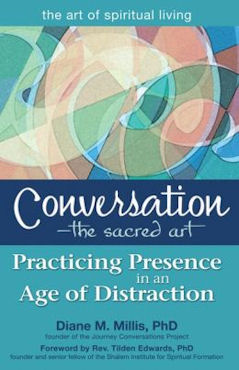
|
Posted June 24, 2013
Book: Conversation -- The Sacred Art: Practicing Presence in an Age of Distraction Author: Diane M. Millis Skylight Paths. Woodstock, Vermont. 2013. Pp. 154 An Excerpt from the Jacket:
We often find ourselves distracted and overwhelmed by a constant stream of information and demand for connectivity. Now more than ever, we need to develop our capacity for greater presence in our daily lives and relationships. One of the best ways to do this is by improving the quality of our conversation. Dr. Diane Millis offers us inspirational stories, insights and spiritual practices from many faith traditions to increase our awareness of the deep, natural holiness waiting to be unlocked in our everyday encounters. This resource is a catalyst for anyone who would like to enrich seemingly ordinary conversations as well as for leaders in educational, ministry and corporate settings who want to: Increase their capacity to listen deeply Become more self-aware and attentive to others Learn how to move beyond conventional topics to exploring purpose, meaning and values in conversation An Excerpt from the Book: Noticing in Conversation Learning to notice is a sacred invitation. In his book, Spiritual Mentoring, Tad Dunne reminds us that noticing is fundamental to being human. "Before any knowledge of God came questions about God. Before any questions came noticing. Before noticing came a dark and relentless desire. It can come as a shock to realize this essential role of human noticing questions, and desire in divine revelation. But it is a healthy shock. We discover a profound camaraderie with all the men and women who seek the truth about life. We are engaged in the same struggle they are. What they discovered about God they pass on to us, not as mere information but as an invitation to notice, to wonder, to question and to realize for ourselves." The more we take the time to look closely, to pay attention to what glimmers and moves us deeply, and to try to put into words what we are noticing, the more our awareness of the sacredness of everyday life will be nurtured. We extend this invitation in our conversation with others whenever we move from asking conventional questions to offering questions that invite others to notice, name, and nurture their awareness of what they find to be life-giving. Instead of asking the next person we meet, "What do you do for a living?" we might try, "Where are you finding joy in your life these days?" Instead of asking a child, "How do you like school?" we might try, "What's the best part of being a fourth grader?" instead of asking our coworker, "What can be done to improve the morale in our office?" we might ask instead, "What do you enjoy most about your work?" Through this commitment to noticing and naming what we hold sacred, and inviting others to do the same, we increase our collective awareness of the sacred in our midst. We grow to see more of the truth, beauty, and goodness in our daily lives --- "to look at ordinary things quite closely to see if there isn't a little bit of something special about them." Table of Contents: Part One: What is the Sacred Art of Conversation? 1. Encountering the sacred within practice 2. Encountering the sacred in each other 3. Encountering the sacred between us Part Two: Gateways for conversation 4. Listening to your life 5. Noticing and naming what gives you life 6. Discerning a heart-centered path Part Three: Practicing the sacred art of conversation 7. Practicing attentive presence 8. Practicing receptive presence 9. Practicing compassionate presence Appendix 1: Cultivating contemplation and compassion in community through journey conversations Appendix 2: Appreciatively focused conversations at home and work Appendix 3: Conversation catalysts |
|
